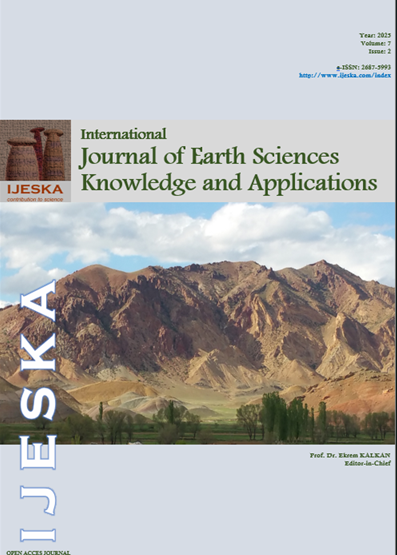Urban Heat Island ‒ A Strong Contributor to Climate Change ‒ Case Study of Jaipur with Emphasis on Urban Forestry and Sustainable Development
Keywords:
Urban Heat Island effect, energy reduction, climate change, urban forestry, mitigating measuresAbstract
Urban sectors are posing serious challenges presently and are likely to become an issue of great global concern in future. Around 55 percent of the total global carbon footprint is contributed from the urban sector resulting in climate change. The resulting contributing factors are mainly on account of continuous increasing urban population, non-optimization of concreting to non-concreting urban surface and vertical to horizontal spread of urban area coupled with other environmental parameters of relevance. These environmental issues are in the form of insufficient urban air ventilation, increasing urban heat island, inadequate carrying capacity of road network leading to traffic congestion resulting in enhanced air pollution, inadequate disposal and treatment of municipal solid waste and sewage and so on so forth. To address some of the issues referred to above, present research has been made by the authors to assess the urban heat island with emphasis on infusion of urban forestry. A case study has been carried out for Jaipur, Rajasthan, which has been divided into 14 grids with 56 locations where temperatures were recorded during the months of April to June 2023. Urban heat islands were calculated for different locations in Jaipur and isopleths were drawn using Surfer-9 software. An attempt has also been made to estimate an increase in energy consumption on account of the Urban Heat Island effect in Jaipur. To mitigate such an alarming UHI which is partly responsible for climate change, various mitigating measures were described with special reference to infusion of Urban Forestry in Jaipur.
References
Agarwal, R., Rijhwani, S., 2021. Diversity of Economically Useful Wild Plants of Jhalana Forest, Jaipur. International Journal of Life science and Pharma Research 11 (1), 38-43. https://doi.org/10.22376/ijpbs/lpr.2021.11.1.L38-4.
Aleksandrowicz, O., Vuckovic, M., Kiesel, K., Mahdavi, A., 2017. Current Trends in Urban Heat Island Mitigation Research: Observations Based on a Comprehensive Research Repository. Urban Climate 21, 1-26. https://doi.org/10.1016/j.uclim.2017.04.002.
Authority, J.D., 2025. Existing Landuse-Draft Master Development Plan. Jaipur: Jaipur Development Authority.
Bhattacharjee, A., Kamble, S., Kamal, N., Golhar, P., Kumari, P., Bhargave, A., 2022. Urban Heat Island Effect: A Case Study of Jaipur, India. International Journal of Earth Sciences Knowledge and Applications 4 (1), 133-139.
Bose, P., 2024. Nexus dynamics: the impact of environmental vulnerabilities and climate change on refugee camps. Oxford Open Climate Change, 11.
Elizabeth, A., Barnes, J.W.U., 2019. Geophysical Research Letters. Viewing Forced Climate Patterns Through an AI Lens.
Hardy, J.T., 2003. Climate Change: Causes, Effects and Solutions. West Sussex: John Wiley and Sons Ltd.
Jabbar, H.K., Hamoodi, M.N., Al-Hameedawi, A.N., 2023. Urban heat islands: a review of contributing factors, effects and data. 3rd International Conference on Smart Cities and Sustainable Planning (p. 10). IOP Conf. Series: Earth and Environmental Science.
Karmakar, D., Ghosh, T., Padhy, P.K., 2019. Effects of air pollution on carbon sequestration potential in two tropical forests of West Bengal, India. Ecological Indicators 98, 377-388. https://doi.org/10.1016/j.ecolind.2018.11.014.
Lustgarten, A., 2020. How Climate Migration Will Reshape America. Millions will be displaced. Where will they go? Retrieved from How climate migration will reshape America: https://www.nytimes.com/interactive/2020/09/15/magazine/climate-crisis-migration-america.html.
Mohajerani, A., Bakaric, J., Jeffrey-Bailey, T., 2017. The Urban Heat Island Effect, its Causes and Mitigation. Thermal Properties of Asphalt Concrete. Journal of Environmental Management 197, 522–538. https://doi.org/10.1016/j.jenvman.2017.03.095.
NASA, 2019. Evidence. There is unequivocal evidence that Earth is warming at an unprecedented rate. Human activity is the principal cause. Retrieved from National Aeronautics and Space Administration. https://science.nasa.gov/climate-change/evidence/.
Nuruzzaman, M., 2015. Urban Heat Island: Causes, Effects and Mitigation Measures ‒ A Review. International Journal of Environmental Monitoring and Analysis 67-73.
Oke, J.A., 2003. Thermal Remote Sensing of Urban Climates. Remote Sensing of Environment 86 (3), 370 – 384. https://doi.org/10.1016/S0034-4257(03)00079-8.
Oke, T.R., 1973. City Size and the Urban Heat Island. Atmosphere, Environment 7 (8), 769-779. https://doi.org/10.1016/0004-6981(73)90140-6.
Watson J., 2023. PBS Newshour. Retrieved from Climate change is already fueling global migration. The world isn’t ready to meet people’s changing needs, experts: https://www.pbs.org/newshour/world/climate-change-is-already-fueling-global-migration-the-world-isnt-ready-to-meet-peoples-needs-experts-say.
Westerhold, T., Marwan, N., Drury, A.J., Liebrand, D., Agnini, C., Anagnostou, E., Barnet, J., Bohaty, S.M., De Vleeschouwer, D., Fabio, F., Frederichs, T., Hodell, D., Holbourn, A.E., Kroon, D., Lauretano, V., Littler, K., Lourens, L., Lyle, M., Pälike, H., Röhl, U., Tian, J., Wilkens, R.H., Wilson, P.A., Zachos, J.C., 2020. An astronomically dated record of Earth’s climate and its predictability over the last 66 million years. Science 369 (6509), 1383-1387. https://doi.org/10.1126/science.aba68.
WHO, 2016. World Health Organization 2016 Health as the Pulse of the New Urban Agenda: United Nations. Conference on Housing and Sustainable Urban Development, Quito.
Downloads
Published
Issue
Section
License
Copyright (c) 2025 Anindita Bhattacharjee, Tania Das, Akshey Bhargava

This work is licensed under a Creative Commons Attribution-NonCommercial-NoDerivatives 4.0 International License.
The authors keep the copyrights of the published materials with them, but the authors are aggee to give an exclusive license to the publisher that transfers all publishing and commercial exploitation rights to the publisher. The puslisher then shares the content published in this journal under CC BY-NC-ND license.



